[Opinion] Section 194R – A Jigsaw Puzzle
- Blog|News|Income Tax|
- 3 Min Read
- By Taxmann
- |
- Last Updated on 27 August, 2022
Sachin Garg & Sidharth Sipani – [2022] 141 taxmann.com 401 (Article)
Since ages, there has been a practice of providing benefits and perquisites to business connections and stakeholders in the commercial world. Employers have been providing it to their employees, business houses have been providing it to their customers, suppliers, and other important connections in the supply chain. Benefits and perquisites have traditionally been paid in cash or partly in cash and partly in kind.
As providing benefit or perquisite is an old tradition, the tax laws also provided for its taxability. Taxability in the case of employer-employee relationship has been provided in section 17 of the Income Tax Act, 1961 (‘the Act’). If the benefit and perquisite is emanating out of business or profession, its taxability is covered by section 28 of the Act.
Even though the taxability of benefit or perquisite is taxable in the hands of the recipient, the Government observed that in many cases recipient failed to report receipt of such benefit of perquisite in their return of income. Accordingly, the Government has introduced section 194R in the Act to provide for deduction of tax at source by the payer of benefit or perquisite to a resident before providing such benefit or perquisite. The said provisions have been made effective from July 01, 2022.
However, as it is said that with great power comes great responsibility, in relation to tax amendments, it can be said that with every amendment comes multiple issues and challenges.
In order to clarify issues and challenges emanating from the provisions of section 194R, Central Board of Direct Taxes (‘CBDT’), in exercise of its power under section 194R(2) of the Act, issued guidelines in the form of Circular No. 12 of 2022 dated June 16, 2022. However, the guidelines seem to be one of the various examples where there has been an overlap in the functions and powers of the Legislature and Executive.
Key provisions of section 194R
For academic purposes, key provisions of section 194R are tabulated below:
| Applicability | Any benefit or perquisite, whether convertible into money or not, arising from business or the exercise of a profession of the recipient |
| Rate | 10% |
| Deductor | Any person responsible for providing benefit or perquisite, other than a person being an individual or a HUF, whose total sales, gross receipts, or turnover does not exceed INR 1 Cr. in case of business or INR 50 Lakhs in case of profession, during immediately preceding financial year |
| Deductee | Any person resident in India receiving a benefit or perquisite |
| Threshold | INR 20,000 per recipient per annum |
| Timing of deduction | Before providing benefit or perquisite |
Binding nature of Guidelines
Historically, majority of the circulars issued by CBDT in terms of the powers conferred under section 119 of the Act, and it was a settled position that such circulars are binding on the income tax department only and not on the taxpayers. Also, the circulars cannot expand or contract the applicability of the provisions of the Act and impose additional burden on the taxpayer.
However, the Guidelines under section 194R have been issued pursuant to the powers provided to the CBDT under section 194R(2) and 194R(3) of the Act. Section 194R(2) provides that guidelines may be issued by CBDT to “remove difficulty” which arise in giving effect to the provisions of section 194R. Section 194R(3) provides that every guideline issued by the CBDT shall be laid before each House of Parliament and shall be binding on the Revenue as well as the person providing any benefit or perquisite.
We will see in the ensuing paragraphs how the Government in the name of removing difficulties seems to have enlarged the scope of the provisions of section 194R of the Act through the Guidelines.
Click Here To Read The Full Article
Disclaimer: The content/information published on the website is only for general information of the user and shall not be construed as legal advice. While the Taxmann has exercised reasonable efforts to ensure the veracity of information/content published, Taxmann shall be under no liability in any manner whatsoever for incorrect information, if any.

Taxmann Publications has a dedicated in-house Research & Editorial Team. This team consists of a team of Chartered Accountants, Company Secretaries, and Lawyers. This team works under the guidance and supervision of editor-in-chief Mr Rakesh Bhargava.
The Research and Editorial Team is responsible for developing reliable and accurate content for the readers. The team follows the six-sigma approach to achieve the benchmark of zero error in its publications and research platforms. The team ensures that the following publication guidelines are thoroughly followed while developing the content:
- The statutory material is obtained only from the authorized and reliable sources
- All the latest developments in the judicial and legislative fields are covered
- Prepare the analytical write-ups on current, controversial, and important issues to help the readers to understand the concept and its implications
- Every content published by Taxmann is complete, accurate and lucid
- All evidence-based statements are supported with proper reference to Section, Circular No., Notification No. or citations
- The golden rules of grammar, style and consistency are thoroughly followed
- Font and size that’s easy to read and remain consistent across all imprint and digital publications are applied








 CA | CS | CMA
CA | CS | CMA


